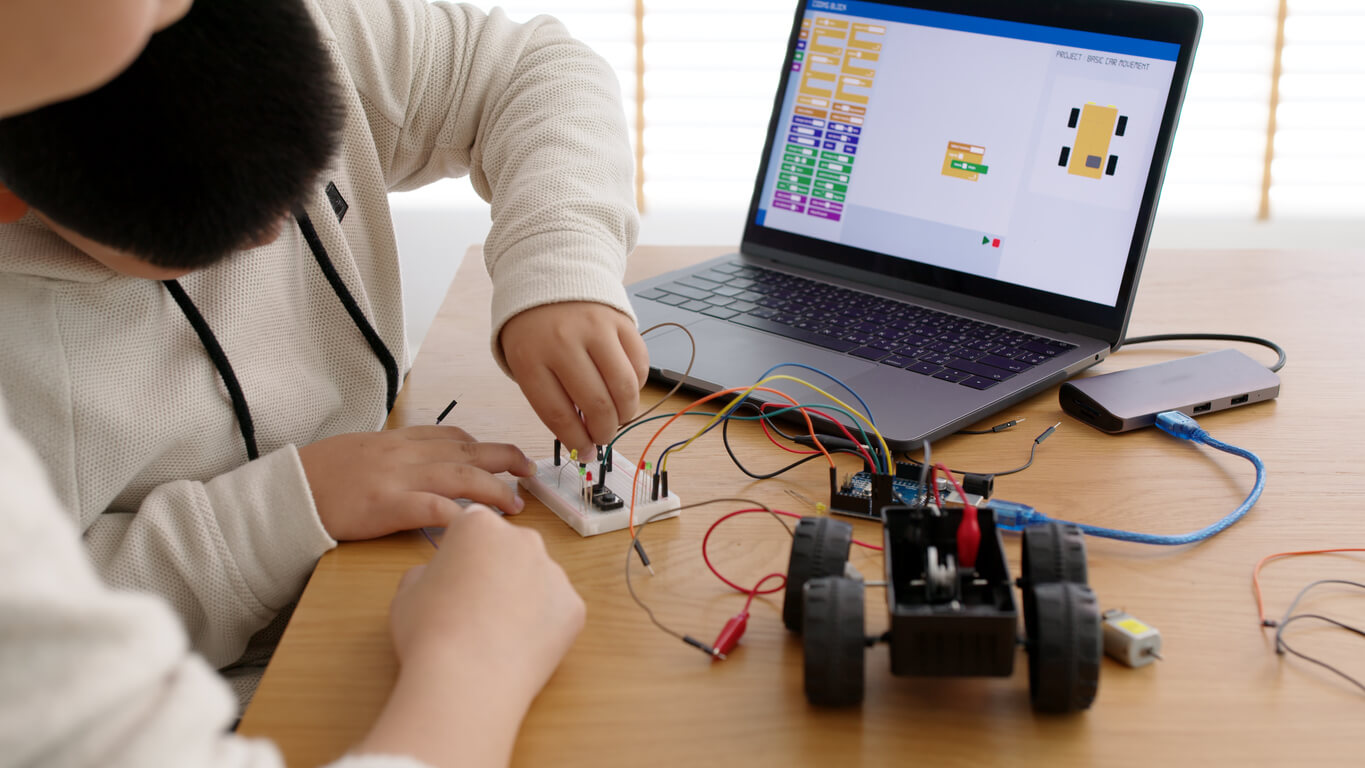6 Benefits of Learning Programming for Children


Written and verified by the teacher Samanta Ruiz
The digital world is growing by leaps and bounds, and children are immersed in it from an early age. However, parents ask themselves the following question: Should children learn to program? Know the benefits of children learning programming and you’ll find the answer!
Benefits of learning to read and write code
Computer literacy is part of the new literacy. So, getting in tune with it is critical for children and youth. Adding skills and knowledge has its advantages, but learning programming in particular brings a number of benefits that are useful for many aspects of life. Learn about them below.
1. Learning programming teaches kids how to solve problems
Learning to code increases the ability of little ones to tackle and solve problems efficiently. Coding challenges set in motion a series of steps that include identifying problems, prioritizing work, and implementing the most appropriate solutions. In this process, children acquire a range of cognitive and social skills that are transferable to other learning and life situations.

2. Programming stimulates the development of computational thinking and logic
Computational thinking is a simple concept that means “thinking like a computer”. This is breaking large problems into small ones to find patterns. As this workflow progresses, children learn to use logic and better understand how algorithms work. This will have a positive impact on learning math and problem-solving methods.
3. Learning programming activates and strengthens creative skills
Creative people have the ability to invent new things and present different visions of the situations we’re presented with. Programming allows children to further develop their creativity and conduct experiments in the digital environment. They really enjoy these types of games in which creative thinking is used to tell stories, make animations, and learn a little art and design along the way. These skills and knowledge will last forever!
4. Programming encourages socialization and teamwork
Contrary to popular belief, programming isn’t a solitary activity, and the best results with it occur in collaborative and participatory environments. The task of reading and writing code is much more efficient if done in a team. A study published in the Journal of Information and Software Technology explains that “improving performance experiences requires the integration of soft factors such as communication, spirit, team identity and values, into the overall development process.”
5. Helps develop perseverance and resilience
Computer science is a discipline that’s developed on a trial-and-error basis. Program failures are constant and coders must learn that failures are learning and perseverance is the answer.
Tracking down a mistake is often exhausting, but it helps build resilience, overcome frustration, and keep going until the solution is found. By doing this, children learn that failure is transitory and develop a growth mindset that will serve them well in their studies, future work, and life in general.

6. Programming places children in the job landscape of the future
Many children in kindergarten and elementary school today will work in development and programming professions. Technology job openings are increasing and talent is scarce, so learning to program is a great opportunity for a successful future career.
The best part is that the discipline has many different applications and includes the full range of STEAM (Science, Technology, Engineering, Arts, and Math). It also includes work in areas such as social sciences, languages, audiovisual content generation, and games, among others.
Programming in schools
The benefits of children learning programming have been the starting point for many governments. As a result, they’ve incorporated certain subjects related to computer science into their educational systems. Countries such as Estonia, the United Kingdom, and Finland are the pioneers in Europe. For their part, China, Singapore, and the United States have also standardized the teaching of programming in schools.
In the case of Spain, the program Código Escuela 4.0 has been launched to “foster the development of a high-performance digital education ecosystem” and “improve digital competencies and capabilities for digital transformation”.
In the 1990s, the founder of Apple said the following:
“Everyone should learn to program. It’s like studying law, I’m not saying everyone has to be a lawyer but it’s useful because it helps you think a certain way, in the same way that programming forces you to think another way. Everyone should take a year or two out of their life learning to program.”
-Steve Jobs-
Without a doubt, his vision was spot on. The future is already here and children are the main protagonists.
The digital world is growing by leaps and bounds, and children are immersed in it from an early age. However, parents ask themselves the following question: Should children learn to program? Know the benefits of children learning programming and you’ll find the answer!
Benefits of learning to read and write code
Computer literacy is part of the new literacy. So, getting in tune with it is critical for children and youth. Adding skills and knowledge has its advantages, but learning programming in particular brings a number of benefits that are useful for many aspects of life. Learn about them below.
1. Learning programming teaches kids how to solve problems
Learning to code increases the ability of little ones to tackle and solve problems efficiently. Coding challenges set in motion a series of steps that include identifying problems, prioritizing work, and implementing the most appropriate solutions. In this process, children acquire a range of cognitive and social skills that are transferable to other learning and life situations.

2. Programming stimulates the development of computational thinking and logic
Computational thinking is a simple concept that means “thinking like a computer”. This is breaking large problems into small ones to find patterns. As this workflow progresses, children learn to use logic and better understand how algorithms work. This will have a positive impact on learning math and problem-solving methods.
3. Learning programming activates and strengthens creative skills
Creative people have the ability to invent new things and present different visions of the situations we’re presented with. Programming allows children to further develop their creativity and conduct experiments in the digital environment. They really enjoy these types of games in which creative thinking is used to tell stories, make animations, and learn a little art and design along the way. These skills and knowledge will last forever!
4. Programming encourages socialization and teamwork
Contrary to popular belief, programming isn’t a solitary activity, and the best results with it occur in collaborative and participatory environments. The task of reading and writing code is much more efficient if done in a team. A study published in the Journal of Information and Software Technology explains that “improving performance experiences requires the integration of soft factors such as communication, spirit, team identity and values, into the overall development process.”
5. Helps develop perseverance and resilience
Computer science is a discipline that’s developed on a trial-and-error basis. Program failures are constant and coders must learn that failures are learning and perseverance is the answer.
Tracking down a mistake is often exhausting, but it helps build resilience, overcome frustration, and keep going until the solution is found. By doing this, children learn that failure is transitory and develop a growth mindset that will serve them well in their studies, future work, and life in general.

6. Programming places children in the job landscape of the future
Many children in kindergarten and elementary school today will work in development and programming professions. Technology job openings are increasing and talent is scarce, so learning to program is a great opportunity for a successful future career.
The best part is that the discipline has many different applications and includes the full range of STEAM (Science, Technology, Engineering, Arts, and Math). It also includes work in areas such as social sciences, languages, audiovisual content generation, and games, among others.
Programming in schools
The benefits of children learning programming have been the starting point for many governments. As a result, they’ve incorporated certain subjects related to computer science into their educational systems. Countries such as Estonia, the United Kingdom, and Finland are the pioneers in Europe. For their part, China, Singapore, and the United States have also standardized the teaching of programming in schools.
In the case of Spain, the program Código Escuela 4.0 has been launched to “foster the development of a high-performance digital education ecosystem” and “improve digital competencies and capabilities for digital transformation”.
In the 1990s, the founder of Apple said the following:
“Everyone should learn to program. It’s like studying law, I’m not saying everyone has to be a lawyer but it’s useful because it helps you think a certain way, in the same way that programming forces you to think another way. Everyone should take a year or two out of their life learning to program.”
-Steve Jobs-
Without a doubt, his vision was spot on. The future is already here and children are the main protagonists.
All cited sources were thoroughly reviewed by our team to ensure their quality, reliability, currency, and validity. The bibliography of this article was considered reliable and of academic or scientific accuracy.
- Benefits Of Learning Coding At A Young Age. (s/f). Linkedin.com. Recuperado el 26 de septiembre de 2022, de https://www.linkedin.com/pulse/benefits-learning-coding-young-age-anita-singh/
- Fagerholm, F., Ikonen, M., Kettunen, P., Münch, J., Roto, V., & Abrahamsson, P. (2015). Performance Alignment Work: How software developers experience the continuous adaptation of team performance in Lean and Agile environments. Information and Software Technology, 64, 132–147. https://www.sciencedirect.com/science/article/abs/pii/S0950584915000269
- INTEF España (2017). Programación, Robótica y Pensamiento Computacional en el aulaIntef.es. Recuperado el 26 de septiembre de 2022, de https://code.intef.es/wp-content/uploads/2018/10/Ponencia-sobre-Pensamiento-Computacional.-Informe-Final.pdf
- Niños programadores: el futuro que ya nos alcanzó. (2021, agosto 6). CNN. https://cnnespanol.cnn.com/2021/08/06/ninos-programadores-futuro-nos-alcanzo-orix/
This text is provided for informational purposes only and does not replace consultation with a professional. If in doubt, consult your specialist.








